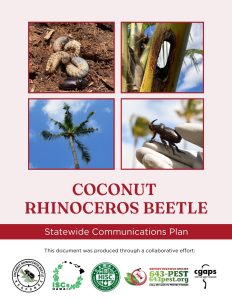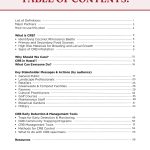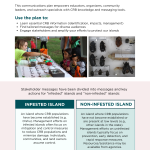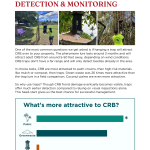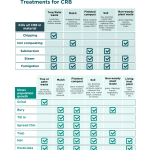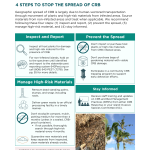Hawaii CRB Communications Plan
Hawai’i Statewide Coconut Rhinoceros Beetle Communications Plan
This plan serves as a compass for educators, community leaders, organizers, and outreach specialists, providing them with the essential knowledge and tools to communicate effectively about the Coconut Rhinoceros Beetle (CRB). It is a strategic resource designed to enhance understanding of CRB identification, its impacts, and the management practices necessary to protect our islands. With specific messaging tailored for diverse audiences, this guide aims to activate stakeholders across our communities to amplify our collective efforts in preserving the natural and cultural beauty of Hawai’i from the impacts of CRB.
Download full plan here:
Hawaiʻi Statewide CRB Communications Plan (28 MB PDF)
Engaging Stakeholders
The Hawai’i CRB Communications Plan addresses a diverse range of audiences, each with a critical role in the prevention and management of CRB infestations. This communications plan offers specialized messages and actions for:
- General Public: CRB impacts us all, from increased landscaping costs to the loss of treasured trees. By learning about CRB, promptly reporting sightings, managing potential breeding sites, and actively participating in community control efforts, everyone can play a crucial role in early detection and prevention. Public reporting is vital for identifying new infestations and safeguarding our islands.
- Landscape Professionals: Landscape professionals have a frontline role in detecting CRB and preventing its spread, as they come into close contact with CRB feeding sites like the crown of palms, and often import, generate, transport, or use a large amount of materials that CRB could breed in.
- Retailers: Retailers play a vital role in preventing the spread of CRB by ensuring products like bagged soils, compost, and mulch, as well as potted plants are pest-free. Educating customers adds another layer of defense.
- Green waste & Compost Facilities: Green waste and compost facilities are a crucial link in CRB management, transforming potential breeding grounds into safe resources. Without their commitment to safe disposal options and compost production, controlling CRB becomes significantly harder. Safe facilities protect our communities, and ensures reliable options for responsible disposal and sourcing of materials. This partnership is vital in combating CRB spread.
- Farmers: Farmers stand to lose much from CRB: crop losses, costly infrastructure changes and control costs, and even decreased ability to feed our communities. But they also hold the power to detect CRB early and use integrated pest management strategies, leading the fight against this pest.
- Cultural Practitioners: From food sovereignty to unique coconut varieties, weaving materials, and loulu palms for hale building, CRB endangers the materials and knowledge woven into Hawaiian culture. Sacred royal groves like Kapuāiwa on Moloka’i and Wailuanuihoʻano on Kaua’i could be lost. Cultural practitioners carry the kuleana to protect these resources and ensure traditions thrive for generations to come.
- Golf Courses: Golf courses have been ground zero for CRB infestations across the state. Irrigated landscapes and abundant palms create ideal breeding conditions for this destructive pest. CRB threatens not only the visual appeal of courses but also their usability and economic viability, as the recent palm devastation at Oʻahu golf courses demonstrates.
- Maintenance Staff: Maintenance crews on large properties play a vital role in CRB control. These lands are often connected to broader ecosystems, extending their kuleana beyond property boundaries. Through regular landscaping work, they have direct contact with potential breeding sites and host plants. By developing and implementing site-specific CRB plans, managers and crews can work together to protect these vital resources.
- Botanical Gardens: Botanical gardens serve as sanctuaries for endangered native palms and hubs of plant knowledge. These spaces face unique CRB threats due to dense plantings and the vulnerability of loulu to CRB. Safeguarding these treasures demands proactive CRB practices and fostering awareness among docents, visitors, plant enthusiasts, and conservation partners. Shared knowledge and action will protect these vital collections.
- Military: The military’s extensive land holdings and control over regional transport networks require exceptional biosecurity leadership. To protect Hawai’i and the Pacific from CRB, enhanced protocols and collaborative efforts are essential.
What Can Everyone Do? Here are four steps we can all take to stop the spread of CRB. Share this guide with others to get them engaged.
- Be Vigilant: Learn to identify CRB and report sightings.
- Take Preventative Measures: Manage green waste to reduce breeding sites.
- Community Action: Participate in local trapping and monitoring initiatives. If you live on a CRB infested island, work with your neighbors to address CRB on the community level.
- Educate and Advocate: Spread awareness and support community efforts.

